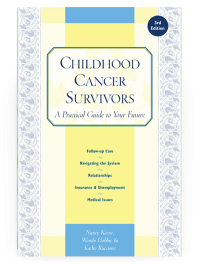Childhood Cancer Survivors
Recommended follow-up for survivors
Some tests are recommended to monitor your long-term health. By screening for problems that may occur, you can quickly identify and treat them. Most survivors of childhood cancer should have the following tests every year: complete blood count, liver function studies, urinalysis, and measurements of blood pressure, pulse, respirations, height, and weight. In addition, the following tables list some tests you should have based on the specific treatments you received. Refer to Table 6-1 for tests after chemotherapy, Table 6-2 for tests after radiation, and Table 6-3 for tests after surgery. Other treatments are listed in Table 6-4 .
For comprehensive and up-to-date recommendations, refer to the long-term follow-up guidelines from the Children’s Oncology Group at www.survivorshipguidelines.org . Recommendations are being regularly updated as new information is learned about late effects, so survivors and their healthcare providers should check these recommendations periodically.
Table 6-1. Tests After Chemotherapy
|
Recommended Follow-Up Testing |
|
|---|---|
|
Bleomycin (Blenoxane ® ) Busulfan (Myleran ® ) Nitrosoureas (CCNU, BCNU) |
|
|
Cisplatin (Platinol ® ) Carboplatin (Paraplatin ® ) |
|
|
Cyclophosphamide (Cytoxan ® ) |
|
|
Ifosfamide (Ifex ® ) |
|
|
Nitrogen mustard (mechlorethamine or Mustargen ® ) Lomustine (CCNU) Carmustine (BCNU) |
|
|
Daunorubicin (Cerubidine ® ) Doxorubicin (Adriamycin ® ) Epirubicin Idarubicin Mitoxantrone |
|
|
High-dose cytarabine (ARA-C) |
|
|
Asparaginase |
|
|
Intrathecal medications:
|
|
|
Mercaptopurine (6-MP or Purinethol ® ) Thioguanine (6-TG) |
|
|
Prednisone Dexamethasone (Decadron ® ) |
|
|
Vincristine (Oncovin ® ) |
|
|
Etoposide (VP-16 or Vepesid ® ) Teniposide (VM-26) |
|
Table 6-2. Tests After Radiation
Table 6-3. Recommendations and Tests After Surgery
|
If Treatment Included |
Recommendations and Follow-Up Testing |
|---|---|
|
Adrenal gland removal |
|
|
Abdominal surgery |
|
|
Amputation |
|
|
Enucleation (removal of the eye) |
|
|
Laparotomy |
|
|
Limb salvage |
|
|
Nephrectomy (removal of a kidney) |
|
|
Neurosurgery |
|
|
Splenectomy |
|
Table 6-4. Other Tests
|
Recommended Follow-Up Testing |
|
|---|---|
|
Transfusions |
|
|
Primary disease |
Counseling and surveillance for second cancers if the primary disease was:
|
|
Health maintenance |
|
|
Family history of cancer |
|
Table of Contents
All Guides- 1. Survivorship
- 2. Emotions
- 3. Relationships
- 4. Navigating the System
- 5. Staying Healthy
- 6. Diseases
- 7. Fatigue
- 8. Brain and Nerves
- 9. Hormone-Producing Glands
- 10. Eyes and Ears
- 11. Head and Neck
- 12. Heart and Blood Vessels
- 13. Lungs
- 14. Kidneys, Bladder, and Genitals
- 15. Liver, Stomach, and Intestines
- 16. Immune System
- 17. Muscles and Bones
- 18. Skin, Breasts, and Hair
- 19. Second Cancers
- 20. Homage
- Appendix A. Survivor Sketches
- Appendix B. Resources
- Appendix C. References
- Appendix D. About the Authors
- Appendix E. Childhood Cancer Guides (TM)

